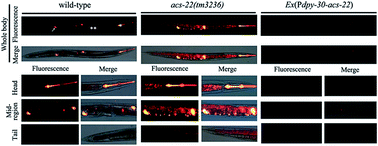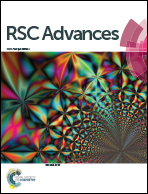ACS-22, a protein homologous to mammalian fatty acid transport protein 4, is essential for the control of the toxicity and translocation of multi-walled carbon nanotubes in Caenorhabditis elegans†
Abstract
Biodistribution and translocation are important for the generation of the toxicity of multi-walled carbon nanotubes (MWCNTs) in organisms. However, we know little about the molecular mechanisms of MWCNT translocation. In Caenorhabditis elegans, the acs-22 gene encodes a protein homologous to mammalian FATP4 (fatty acid transport protein 4). In this study, we employed a C. elegans in vivo assay system to investigate the possible function of ACS-22 in regulating the toxicity and translocation of MWCNTs. Prolonged exposure to MWCNTs significantly decreased transcriptional expression of the acs-22 gene. Loss-of-function mutation of the acs-22 gene strengthened MWCNT toxicity to the functions of both primary targeted organs such as intestine and secondary targeted organs such as neurons and reproductive organs; however, overexpression of the acs-22 gene reduced the toxicity of MWCNTs to the functions of both primary and secondary targeted organs. Loss-of-function mutation of the acs-22 gene enhanced the distribution and translocation of MWCNTs in both primary and secondary targeted organs, whereas overexpression of the acs-22 gene inhibited the distribution of MWCNTs in primary targeted organs and prevented translocation of MWCNTs into secondary targeted organs. Moreover, our results demonstrated the important function of ACS-22 in intestine to be in limiting the toxicity and translocation of MWCNTs. Therefore, our data suggest an essential role of ACS-22 in regulating the toxicity and translocation of MWCNTs in nematodes. Our results will provide important clues for further examination of the molecular mechanisms of translocation of MWCNTs in organisms.


 Please wait while we load your content...
Please wait while we load your content...